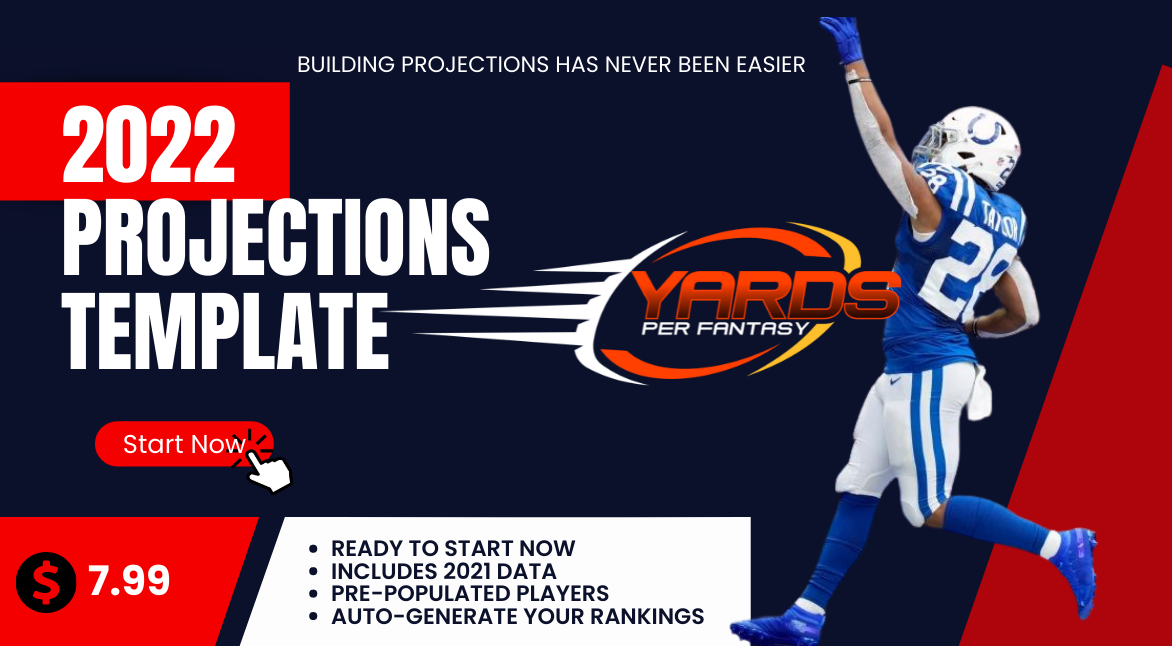 Draft With Us On Underdog! Use Promo-Code: YARDSPER for a 100% deposit match up to $100!
Draft With Us On Underdog! Use Promo-Code: YARDSPER for a 100% deposit match up to $100!
In Part 1 of this dynasty strategy series, I discussed rebuilding your dynasty team the “right way.” In Part 2, I lay out my formula for never having to descend into a full rebuild ever again.
Always Reloading, Never Rebuilding
Now that we have rebuilt our team and done it the “right way,” we want to avoid ever having to rebuild again. We want to avoid the never-ending cycle of contending, tearing it down, and building it back up. Continually going through that process is tiring, never mind that we’re wasting precious years basically sitting out and watching someone else take home the hardware. Plus, many teams that descend into full rebuild mode, never make it out the other side. So instead, we want to sustain long-term success and be a contending team every single year. This takes some work so I hope you’re ready.
THE ULTIMATE 2022 DYNASTY ROOKIE DRAFT GUIDE
You’re Allowed To Win Now
One of the biggest mistakes dynasty gamers make is forgetting that they’re allowed to try to win now. Some managers find themselves in a perpetual loop of chasing youth. While that’s great in the early stages of a rebuild, sometimes the end game (winning titles) gets lost. Chasing youth and “potential” to the extreme, ends up driving your team into the ground. That’s because, while “potential” sometimes comes to fruition, players often fail to reach the levels we think they can get to with many not even getting close. Fantasy points win championships, not potential. Going too far the other way, however, will inevitably wind up bringing you right back to rebuild mode.
There’s a way to add production to your crop of young talent and to do it the right way without sacrificing long-term sustained success. Veteran players can often be had at a discounted rate in the offseason especially during draft season when all of your league mates are experiencing peak rookie fever. Once you’re in contender mode, your roster will ideally consist of:
- A handful of low-cost, productive veteran WRs & TEs (age 28-31)
- A strong core of young/prime, peak production WRs & TEs
- A stable of 2-3 high-end, young RBs (ages 21-24)
- 2+ handcuff RBs (doesn’t have to be handcuffs to your own RBs)
- 5 young RBs/WRs/TEs with “potential”
- Superflex: 1 young konami code QB with upside; 1 steady/safe veteran; with 1-2 other QBs you can turn to on bye weeks or as injury replacements; 1-2 upside backups
PROJECTIONS TEMPLATE – GET NOW!
Moving Vets: Better to be a Year Early Than A Year Late
While it’s important to have some veterans on your team to help you compete in the short term, you must be wary of allowing your squad to become an “old team.” The key to this is knowing when to move on from veteran players at the right time. More importantly, it’s getting out before the bottom falls out and their value plummets. My philosophy here is it’s better to move on a year too early than a year too late. Otherwise, you’re going to have a bunch of old farts sitting on your team taking up precious roster spots.
How do we know when the right time to get out is? We can start by understanding the age apex for each position.
Running backs typically perform at their ceiling between ages 22-24. Once they hit age 25, the cliff comes fast. The offseason between a running back’s age 24 and age 25 seasons are the best time to cash out. This is why we want running backs in rookie drafts. Get those early years and move on.
Wide receivers usually find their prime production years between ages 24-27. Selling after the age 27 season is optimal.
Tight ends take longer to break out than the other positions in most cases. It can be a long ramp up to peak production, some even waiting until their second contract (and second team) before hitting their ceiling. We usually get the most out of them between ages 25-28. After that, it’s time to move on.
While there’s nothing wrong with hanging onto a guy beyond their age apex season, I would recommend that being the exception, not the rule. In most cases, it’s recommended you move on, collect your money bag (picks/players) and keep the fire burning with the next generation of players.
Acquire RBs Through The Rookie Draft
Elite running backs are incredibly valuable in fantasy football. You can have a great wide receiver corps, an elite tight end, a top-end quarterback, but without that bellcow back giving you 20-point weeks, you’re not taking home any titles. Unfortunately, the shelf life of these running backs is so short, as discussed above. We really need to get these running backs as early in their careers as possible so we can squeeze as much juice out of their prime years as we can. This is why I recommend spending your rookie picks trying to capture these guys when they’re coming into the league. Running backs with early-round draft capital typically return fantasy value in their rookie seasons. They get immediate opportunity and of all the fantasy positions they have the easiest transition from college to the NFL. At the same time, they only have a short window to perform at peak level. A running back with early draft capital, an all-purpose skill set, and who is entering the league at age-21 is incredibly valuable. That’s why guys like Jonathan Taylor and Breece Hall were so highly sought-after at the 1.01 of rookie drafts in their respective classes. Being 21 rather than 23 gives their dynasty managers an extra two-year window to enjoy dominant production.

Always Replenish The Youth
Once your rebuild is complete and you’re competing for championships, it’s easy to get caught-up in the moment and forget the long-term goal. While it’s totally okay to lean “win-now,” as discussed above, we really want to strike the perfect balance between short-term and long-term success. That’s why it’s incredibly important to continue to replenish the youth on your roster. Chasing the young guns isn’t just for rebuilding teams. One of the mistakes I made early in my dynasty career was seeing my win-now window and becoming aggressively near-sighted. I will continue to reiterate that recognizing your championship window and trying to take advantage is perfectly okay, but there are lethal mistakes to avoid. One of them that I repeatedly made over a three-year stretch on a team that was having a good run and competing for titles during that time was trading away all my first round picks. Actually, it wasn’t even giving up the picks that did me in, it was trading them for the wrong guys. What I mean is I dealt firsts for aging wide receivers who I knew I could never recoup the value from. I traded for late-Bengals career A.J. Green. He was having a great season and I thought he’d be that last piece I needed to get over the hump. Instead, he suffered an injury the very next week and never cracked my lineup again. I dealt him for peanuts a year after his dynasty value cratered. I did the same with Alshon Jeffery and repeated the mistake one more time with T.Y. Hilton. All with similar results.
The lesson I took away was that, sure, it’s fine to trade away firsts to pursue a title, but only when that player is at an age where that value can be returned. Whether that be in a future deal or by providing your team with prime production for multiple seasons. I ended up with a team that went from perennial contender to an old, worthless bunch of bottom-feeders in the blink of an eye. I had no youth to continue the cycle and was sucked into a multi-year rebuild.
As noted above, it’s essential to keep replenishing the youth of your roster even in the midst of a championship run. I now dedicate at least 3-5 spots on every one of my rosters to developmental players. This helps with the bottom of the roster churn and to continue to feed the machine.
Always Leave The Rookie Draft With At Least One Additional Future Pick
I go into every single rookie draft with the same goal in mind: to walk out with at least one additional pick in the following year’s draft. This is just another way of ensuring the youth continues to be replenished. I don’t care if it’s another first or just a measly fourth-rounder. As long as I have something extra I can carry over into next season. Typically this is done by trading back, but it can also be done by trading away players.
Humble Pie
Fact: You’re not as good at player evaluations as you think you are. I know we all think we’re the best at knowing which rookies are going to be studs. However, even the best talent evaluators bat below .500. We have to accept that and account for it in all the moves we make. An example of this is in 2021 when everyone was sure that Kadarius Toney was destined to be a bust. However, he was falling way too low in rookie drafts for a real-life first-rounder. And sure, the jury is still out on how good (or bad) he truly is, there was a point where we had to accept that we don’t know everything and there is absolutely a chance he winds up being a hit. Afterall, the NFL told us they think he’s good by drafting him in the first—even if it was Dave Gettleman making the call.
This goes beyond rookie drafts, too. It’s important we continue to recalibrate our player evaluations based on new information. That information could be a player’s performance on the field. It could be a news item. Or it could be a transaction. Whatever it is, we have to absorb all of the information available to us in order to avoid take-lock. Otherwise, opportunities will be missed to acquire a breakout star or to offload a screaming bust.








